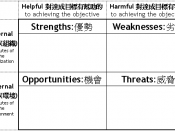U.S. sales of organic foods and beverages have grown from $1 billion in 1990 to $24.8 billion in 2009. Sales in 2009 represented 5.1% growth over 2008 sales (Industry Statistics and Projected Growth, 2010). These trends are having a significant impact on the food market industry as a whole, and in particular the organic foods markets. Provide a discussion of the trends in the organic foods industry and how these trends will impact the organizations that sell organic foods. Examine the competitive environment that organic foods can create for an organization and apply Porter's model, providing an analysis of each factor relative to the industry. Identify the opportunities and potential threats to the organic foods industry by completing a SWOT analysis. How can a competitive advantage be achieved using the strengths and opportunities identified in the SWOT?
Many practitioners of the organic lifestyle treat it with as much reverence as if it were a religion or spiritual calling.
Why are these devotees so, well, devoted to their personal cause? One blogger who espouses the benefits of organic (or not man made) food on her website says that organic food will literally change your life. In addition, you may avoid feeling ill in the body and the mind, and maybe even live longer, too (Fisher, 2006). Given all the positives for eating organic food, are there any negatives? Unfortunately, yes (Birgenheier, 2007). The most overwhelming argument against eating organically grown food is the higher price tag. With the current state of the economy, this has never been more apropos. For example, research has shown that those who choose to buy solely organic meals pay about 50% more than standard options. If instead the consumer selects organically raised meat and poultry, this figure can skyrocket to 100% more than more readily...


